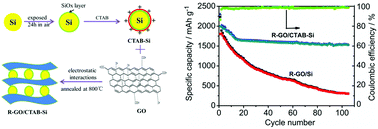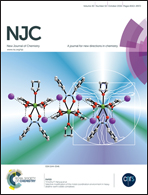A self-assembly strategy for fabricating highly stable silicon/reduced graphene oxide anodes for lithium-ion batteries
Abstract
Reduced graphene oxide (R-GO)/cetyltrimethyl ammonium bromide (CTAB)-coated silicon nanoparticles (Si NPs) were synthesized by a simple all-aqueous directed assembly method at room temperature. The as-obtained material exhibits exceptional lithium storage performance when used as lithium-ion battery anodes, simultaneously attaining remarkable rate capability (1106 mA h g−1 at 2 A g−1), high initial coulombic efficiency (87%), high reversible capacity and good cyclic stability (1550 mA h g−1 and 79% capacity retention over 105 cycles at 0.2 A g−1) with a low capacity fading rate (3.97 mA h g−1 per cycle). The high level of performance is attributed to the synergistic effect of the conductive templated GO and the hierarchical porous structure formed by GO sheets and CTAB treated Si NPs. The unique hierarchical structure could serve as a cushion to buffer the volume change of Si NPs during the charge/discharge process. Moreover, the templated GO not only creates a robust continuous network for rapid transport of both electrons and lithium ions throughout the electrode, but also enables good connection between the Si NPs and CTAB via electrostatic assembly, which can prevent aggregation of the Si NPs and in turn guarantee the stability of the electrode. The experimental results should be very useful in guiding the preparation of long-cycle-life Si-based anode materials with good rate performance using a simple surface modification process.


 Please wait while we load your content...
Please wait while we load your content...